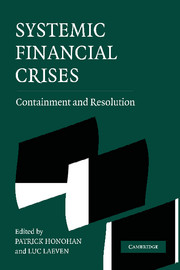Book contents
- Frontmatter
- Contents
- Contributors
- Foreword
- Acknowledgments
- PART ONE INTRODUCTION
- PART TWO CONTAINMENT AND RESOLUTION
- PART THREE MODELS AND ECONOMETRIC EVIDENCE
- 5 Policies for Banking Crises: A Theoretical Framework
- 6 Crisis Resolution, Policies, and Institutions: Empirical Evidence
- PART FOUR STRUCTURAL REFORMS
- Appendix: Banking Crisis Database
- References
- Index
6 - Crisis Resolution, Policies, and Institutions: Empirical Evidence
Published online by Cambridge University Press: 24 August 2009
- Frontmatter
- Contents
- Contributors
- Foreword
- Acknowledgments
- PART ONE INTRODUCTION
- PART TWO CONTAINMENT AND RESOLUTION
- PART THREE MODELS AND ECONOMETRIC EVIDENCE
- 5 Policies for Banking Crises: A Theoretical Framework
- 6 Crisis Resolution, Policies, and Institutions: Empirical Evidence
- PART FOUR STRUCTURAL REFORMS
- Appendix: Banking Crisis Database
- References
- Index
Summary
INTRODUCTION
The large-scale corporate defaults and sharp increases in nonperforming loans that have characterized the many systemic crises of recent years (as described in Chapter 1 and detailed in the Appendix), have typically been accompanied by a general economic slowdown and large fiscal costs of resolution. As emerges clearly from the discussion of previous chapters in this volume, choosing the best way of resolving a systemic crisis and accelerating economic recovery is far from unproblematic. There has been little agreement on what constitutes best practice or even good practice. Many approaches have been proposed and tried to resolve systemic crises more efficiently. Sometimes, contradictory policy recommendations have been made in the midst of a crisis, as happened notably in case of East Asia, but also elsewhere. Part of these differences may arise because objectives of the policy advice have varied. Some have focused on reducing the fiscal costs of financial crises, others on limiting the economic costs in terms of lost output and on accelerating restructuring, whereas again others have focused on achieving long-term, structural reforms. But trade-offs may arise between these objectives. Governments may, for example, through certain policies consciously incur large fiscal outlays in resolving a banking crisis, with the objective of accelerating recovery. Or structural reforms may only be politically feasible in the context of a severe crisis with large output losses and high fiscal costs.
Theory is also ambiguous in its recommendations. One reason for this is that resolution involves inherently complicated coordination problems.
- Type
- Chapter
- Information
- Systemic Financial CrisesContainment and Resolution, pp. 169 - 194Publisher: Cambridge University PressPrint publication year: 2005
- 29
- Cited by



